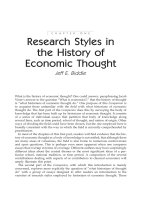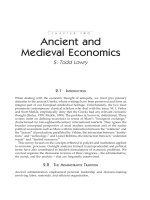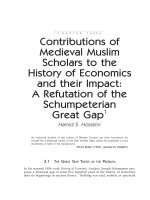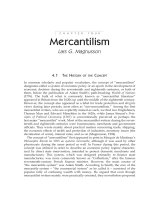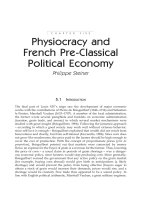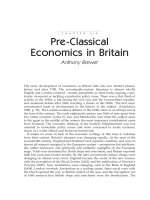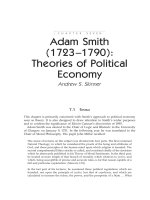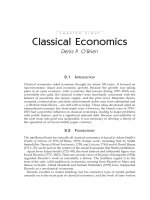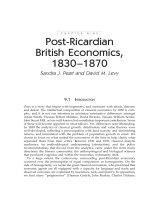A Companion to the History of Economic Thought - Chapter 16 pps
Bạn đang xem bản rút gọn của tài liệu. Xem và tải ngay bản đầy đủ của tài liệu tại đây (205.74 KB, 16 trang )
246 P. GROENEWEGEN
CHAPTER SIXTEEN
English Marginalism:
Jevons, Marshall,
and Pigou
Peter Groenewegen
16.1 INTRODUCTION
English marginalism embraces a group of economists, active in the late nine-
teenth and early twentieth centuries, who used the marginalist method for
analyzing economic questions relating, in the first instance, to the theories of
value and distribution, and later to a wider range of economic questions in the
theories of money, fluctuations, income determination, and growth. Jevons,
Marshall, and Pigou were major contributors to this “marginal revolution” in
England, but not the only important pioneers. Edgeworth and Wicksteed (both
contemporaries of Jevons and Marshall) and Marshall’s Cambridge students, of
whom Pigou was among the first, are also important. The “marginal revolution”
had a well-known international dimension (see Horwitz, ch. 17, this volume;
Walker, ch. 18, this volume) and its impact continues to reverberate in economic
theory.
The concept of marginalism itself has received surprisingly little attention
in the history of economics literature. The word was slow to creep into the lan-
guage of English economics. As Howey (1972) indicates, it was first used by J. A.
Hobson (1914, pp. 174–5, 331–2) in a derogatory manner. The original Palgrave
Dictionary of Political Economy did not have an article on “marginalism.” How-
ever, Edgeworth’s second article on “margin” in its final paragraphs described the
widespread use by mathematical economists of “margins” in economics in both
its theories of consumption and production, to which “Jevons’ exposition . . . forms
an admirable introduction . . . [while their] fullest and most accurate exposition
ENGLISH MARGINALISM: JEVONS, MARSHALL, AND PIGOU 247
. . . is to be found in Prof. Marshall’s Princ. of Econ.” (Edgeworth, 1894, p. 691).
The later Encyclopaedia of the Social Sciences (Seligman, 1948 [1930]) likewise
contains no article specifically devoted to “marginalism.” The same applies to
the New Palgrave Dictionary (Eatwell et al., 1987), which contains articles on
“marginal and average cost pricing,” “marginal efficiency of capital,” “marginal
productivity theory,” and “marginal utility of money” as well as an article on
“marginalist economics.” The last acknowledges “the almost total domination
that marginalist economics has enjoyed for about a century” without igniting
the “spark of an ultimate truth” (Campus, 1987, pp. 321–2). The second quoted
remark is a comment from Sraffa (1926, p. 535), foreshadowing his prelude to a
critique of the dominant marginalist method (Sraffa, 1960, esp. p. v).
This chapter is basically concerned with Jevons’s application of the marginal
method as one of its early pioneers; with Marshall’s masterful exposition of mar-
ginalism, especially in his Principles of Economics; and with its elaboration by
Marshall’s official Cambridge successor, Pigou. The final section briefly refers to
three other leading English economists of the period – Edgeworth, Sidgwick, and
Wicksteed – and in addition raises selected post-Pigovian aspects in the history
of English marginalism.
16.2 WILLIAM STANLEY JEVONS (1835–82)
Jevons was born in Liverpool, the ninth child in a large, middle-class family.
He studied chemistry and engineering at London University in the early 1850s
without taking his degree. In 1853 he went to Sydney (Australia) as assayer
of its new mint, staying there for six years. On his return to London, he
completed his degree. He also started working on a new, mathematical theory
of political economy, on which he read a paper to Section F of the British
Association for the Advancement of Science (Jevons, 1911a [1862]). Unlike his
A Serious Fall in the Value of Gold (1863) and his subsequent book, The Coal
Question (1865), this raised little interest. His major claim to intellectual fame,
Theory of Political Economy, was published in 1871 (2nd edn., 1879). It elaborated
his mathematical theory of political economy, based predominantly on the
pleasure/pain (utility/disutility) principle and employing the marginalist method.
In 1862 he was elected Fellow of the Royal Society. He was appointed Pro-
fessor of Political Economy at London’s University College in 1876, a post
from which he retired in 1880 to have more time for writing. However, he died
early from a swimming accident in 1882. In 1875 Jevons published Money and
the Mechanism of Exchange, and in 1882 The State in Relation to Labour appeared
posthumously. Volumes of essays appeared in 1883 (Methods of Social Reform)
and 1884 (Investigations in Currency and Finance). Although Jevons’s work as an
economist was wide-ranging (for good surveys, see Black, 1981; Peart, 1996), this
essay concentrates on his marginalist treatment of value, exchange, labor, and
capital.
Jevons’s (1911a [1862]) “Brief account of a general mathematical theory of
value” was his first presentation of the marginalist method. After arguing that “a
248 P. GROENEWEGEN
true theory of economy can only be attained by going back to the great springs
of human action, the feelings of pleasure and pain” (Jevons, 1911a [1862], p. 304)
which treated pleasure and utility as synonyms, Jevons focused attention on
what he then called “the coefficient of utility,” described as a “generally dimin-
ishing function of the whole quantity of the object consumed.” This, in his view,
provided the basis for “the most important law of the whole theory” (Jevons,
1911a [1862], p. 307). Earlier (Jevons, 1911a [1862], p. 306), the coefficient of
utility had been defined as “the ratio between the last increment or infinitely
small supply of the object, and the increment of pleasure which it occasions.”
This incrementalist, or marginalist, perspective was then used to explain the
application of labor, the extent of exchange and the rate of interest. In the first,
Jevons established that “labour will be exerted . . . until a further increment will
be more painful than the increment of produce thereby obtained is pleasurable”
(Jevons, 1911a [1862], p. 307). The theory of exchange was then deduced “from
the laws of utility” by postulating that equality of the “increment of utility lost
and gained at the limits of the quantities exchanged” determined the extent of
trade, and that such findings based on a two individuals–two commodities
case were easy to extend to “any number of commodities” and therefore applic-
able to “generalised trade . . . [and] international trade” (Jevons, 1911a [1862],
pp. 308–10). Finally, the 1862 paper showed the universal determination of the
rate of interest “by the ratio which a new increment of produce bears to the increment
of capital by which it was produced,” clearly foreshadowing a marginal productivity
theory of interest.
The Theory of Political Economy elaborated the 1862 propositions without ex-
tending the principles and methods by which they had been originally derived.
Hence it is difficult to treat Jevons’s development of a marginalist method and
its application to utility as part of a “marginalist revolution” in 1871 that was tak-
ing place simultaneously in two other European countries. The eight chapters of
Theory of Political Economy reveal this formal similarity of contents with the 1862
paper. After an introduction (ch. 1), Jevons deals with the theory of pleasure,
pain, and utility (chs. 2 and 3), exchange (ch. 4), labor, rent, and capital (chs. 5–7),
and concluding remarks (ch. 8). The book displays its marginalist credentials
explicitly without using the terminology. Thus, halfway through the work, while
treating the theory of labor, it proclaims, “as in the other questions of Economics,
all depends upon the final increments” (Jevons, 1911b [1871], p. 171), while the
major elements of the subject are identified as “[u]tility, wealth, value, commod-
ity, labour, land, capital” (Jevons, 1911b [1871], p. 1). The book likewise reasserts
the mathematical quality of the subject, “our science must be mathematical, simply
because it deals with quantities” (Jevons, 1911b [1871], p. 3), with the calculus as
the basic mathematical tool, assisted by some Euclidean geometry (the Theory is
extensively illustrated by diagrams). The problem of economics is defined (Jevons,
1911b [1871], p. 37) as the maximization of pleasure (minimization of pain), as
is particularly clearly illustrated in Jevons’s treatment of resource allocation,
including that of labor. The quotation below neatly illustrates the marginalist
nature of his approach to utility and his nonuse of words such as “margin” or
“marginalist” therein:
ENGLISH MARGINALISM: JEVONS, MARSHALL, AND PIGOU 249
We shall seldom need to consider the degree of utility except as regards the last
increment which has been consumed, or, which comes to the same thing, the next
increment which is about to be consumed. I shall therefore commonly use the
expression final degree of utility, as meaning the degree of utility of the last addition.
(Jevons, 1911b [1871], p. 51)
This “degree of utility” is defined as a diminishing function of the quantity of
the commodity held, so that “the degree of utility . . . decreases as that quantity in-
creases” (Jevons, 1911b [1871], p. 53). Optimum allocation in consumption then
requires equalization of the final degree of utility of the commodities consumed
(Jevons, 1911b [1871], p. 61), exchange equilibrium the equality of the price and
the utility ratios (Jevons, 1911b [1871], p. 95), optimum duration of labor supply
the equation of marginal pain (disutility) and marginal benefit (utility) of that
labor (Jevons, 1911b [1871], p. 173), and the optimum allocation of capital the
equalization of interest with the “advantage [in terms of product] of the last
increment of capital [employed]” (Jevons, 1911b [1871], p. 256). Jevons (1911b
[1871], pp. 212–13) also explicitly admitted that versions of the classical theory of
rent, particularly those of James Mill (1821) and McCulloch (1838), were pieces of
economic analysis using the incremental method. In this respect, Keynes (1972
[1936], p. 109) neatly identified Jevons’s contribution as belonging “to the group
of economists whose school of thought dominated the subject for the half-
century after the death of Mill in 1873.”
Jevons’s economic writings encompass more than the marginalist theory of
value and distribution. He made interesting contributions to monetary and busi-
ness cycle theory, and to the economics of energy resource scarcity, which has a
very a contemporary feel about it. The last issue was raised in his The Coal
Question, which analyzed the implications of predictable shortages in the “pres-
ent great supplies of coal,” then “the material source of energy” for Great Britain,
underpinning its great industrial strength that was so successfully built on steel
(Jevons, 1906 [1865], pp. 2–3). Jevons’s treatment raised geological as well
as economic aspects of the problem (impacts on costs, prices, and imports,
economizing the use of coal, and finding substitutes for coal). His conclusion
emphasized the “momentous choice” facing the policy-maker “between brief but
true greatness” from using available coal resources at a rate dictated by current
technology, or a “longer [period] of continued mediocrity” if scarce coal resources
were tightly rationed and industry was thereby effectively starved of its major
energy source (Jevons, 1906 [1865], p. 460). Although marginalist methods could
have been used to advantage in explaining this argument, Jevons did not do so.
Neither did Jevons’s writings on monetary and the associated business cycle
theory, posthumously collected by H. S. Foxwell as Investigations into Currency
and Finance (Jevons, 1884). This volume contains various versions of his famous
sunspot theory of the cycle, as well as his 1863 monograph, A Serious Fall in the
Value of Gold. Essays on social reform (Jevons, 1883) reveal Jevons’s broad social
concerns, ranging from the use (and abuse) of free public libraries and museums,
to that of employing married women in factories, cruelty to animals, and the
drink question, demonstrating that the noted marginalist theorist was also a
250 P. GROENEWEGEN
wide-ranging social scientist. The splendid essays on Cantillon and on the future
of political economy appended to his unfinished and posthumously published
Principles of Economics (Jevons, 1905) show his gifts as a historian of economics.
16.3 ALFRED MARSHALL (1842–1924)
Born in Bermondsey (London) in 1842, Marshall was seven years younger than
Jevons. He was educated at the Merchant Taylor School, where he gained a taste
for mathematics: he subsequently completed the Cambridge Mathematical
Tripos in 1865 as “second wrangler” (second in the first-class honors list), thereby
securing a Fellowship at St John’s College. He then gradually switched to the
moral sciences, concentrating on economics from the early 1870s. His first
book, Economics of Industry (1879, 2nd edn. 1881) was written jointly with his
wife (a former student, whom he had married in 1877). That same year he privately
published material on pure theory (Marshall, 1975b [1879]). After holding
academic positions at Bristol and Oxford, in 1884 Marshall became Professor of
Political Economy at Cambridge. He retired in 1908, when his student Pigou
(discussed below) succeeded him. Marshall’s major book, Principles of Economics,
appeared in 1890 (eighth, definitive, edition in 1920; reprinted in 1961). During
his retirement, he published supplementary volumes (Industry and Trade, 1919;
Money, Credit and Commerce, 1923) as partial substitutes for a second volume
of his Principles, which he never managed to complete.
Marshall is sometimes bracketed with Jevons (whose Theory of Political Economy
he reviewed – Marshall, 1925 [1872]), Menger, and Walras as a participant in the
marginal revolution. This is misleading, if only because his initial price analysis
ignores utility considerations (Marshall, 1975a [1871]). He was, however, a very
significant pioneer of marginal analysis following Cournot (1963 [1838]) and von
Thünen (1966 [1826–63]), from whose work he had benefited at an early stage in
his economic studies. Another differentiating factor from Jevons was that Marshall
never showed strong hostility to his classical predecessors, instead incorporat-
ing part of their work within his own system. This is therefore appropriately
described as neoclassical, a genuine merger of old and new doctrines. Marshall’s
work, including his Principles, also combined theory with much factual matter
drawn from personal empirical observations and painstaking study of empirical
and historical work. Again unlike Jevons, Marshall strongly disliked display-
ing mathematics in his theory – banishing his mathematical economics to an
appendix and burying his diagrams in the footnotes of his Principles. Through
his tremendous influence as a teacher, he founded the Cambridge school of
economics. His economic principles based on supply and demand analysis
endured until well after his death, the Principles surviving as a major university
economics text until after World War II. Useful overviews of his economics are
O’Brien (1981) and Whitaker (1987); Groenewegen (1995) presents a full-scale
biography, including detailed assessment of his economic work.
As a trained mathematician, Marshall immediately took to the marginal method
in analyzing economic problems, to which study of Cournot’s and von Thünen’s
ENGLISH MARGINALISM: JEVONS, MARSHALL, AND PIGOU 251
economics had introduced him. His early economic writings, published with
editorial introductions in Whitaker (1975), clearly illustrate this. Examples are
Marshall’s stress on the “balancing of advantages” in the theory of decision-
making as applied to money (Whitaker, 1975, vol. I, pp. 166–7) and his use of
incrementalist diagrams for explaining the theory of rent (Whitaker, 1975, vol. I,
p. 240). By the early 1870s, sophisticated incremental analysis guided Marshall’s
thinking on tolls, monopoly, and growth and enabled him to sketch a marginal
productivity theory of distribution (Whitaker, 1975, vol. II, pp. 281–3, 284–5, 309–
16, 323–5). This mathematical economics was completely hidden in the initial
textbook presentation of the theory (Marshall and Marshall, 1879) but fully dis-
played in the privately printed pure theory of international trade and domestic
value (Marshall, 1975b [1879], vol. II, pp. 117–81, 186–236).
At a higher level, much of this theory was carefully reworked for Marshall’s
magnum opus, Principles of Economics (Marshall, 1961 [1890]). This had been ori-
ginally intended as a two-volume work, of which the second, never completed,
volume, was at one stage to contain “foreign trade, money and banking, trade
fluctuations, taxation, collectivism [and] aims for the future” (Groenewegen, 1995,
p. 407; its chapter 10 presents a detailed discussion of the long haul of the Prin-
ciples from 1881 to 1922). The first volume became a classic text on value, produc-
tion, and distribution. From the second edition onward, its structure emphasized
the “general relations of demand, supply and value” (book V), and their use for
a theory of “the distribution of the national income” or of wages, rent, interest,
and profit (book VI). These followed two preliminary books, the second of which
was definitional, and two books that provided the foundations for the theory of
value in the theory of demand (book III, “Of wants and their satisfaction”) and of
supply or production (book IV, “The agents of production, land, labour, capital
and organisation”). In addition, later editions of the Principles contained 12
appendices (amounting to over 13 percent of the text) and a concise set of math-
ematical notes. The extent to which Marshall polished his Principles can be seen
in the variorum edition painstakingly prepared by his nephew, C. W. Guillebaud
(Marshall, 1961 [1890]), the edition used in what follows.
The preface to the first edition (reprinted in all subsequent editions) signaled
the specific marginalist intent of the work, and provided a concise statement
of Marshall’s views on the essential role of mathematics in the elucidation of
economic principles. The relevant paragraph can be quoted in full, since it also
provides a clear acknowledgment of Marshall’s mentors in marginal analysis and
of how he saw Jevons’s role in his economics education:
Under the guidance of Cournot, and in a less degree of von Thünen, I was led to
attach great importance to the fact that our observations of nature, in the moral as in
the physical world, relate not so much to aggregate quantities, and that in particular
the demand for a thing is a continuous function of which the “marginal”* increment
is, in stable equilibrium, balanced against the corresponding increment of its cost of
production. It is not easy to get a clear full view of continuity in this aspect without
the aid either of mathematical symbols or of diagrams. The use of the latter requires
no special knowledge, and they often express the conditions of economic life more
252 P. GROENEWEGEN
accurately, as well as more easily, than do mathematical symbols; and therefore
they have been applied as supplementary illustrations in the footnotes of the present
volume. The argument in the text is never dependent on them; and they may be
omitted; but experience seems to show that they give a firmer grasp of many impor-
tant principles than can be got without their aid; and that there are many problems
of pure theory, which no one who has once learnt to use diagrams will willingly
handle in any other way.
* The term “marginal” increment I borrowed from von Thünen’s Der Isolirte Staat,
1826–63, and is now commonly used by German economists. When Jevons’ Theory
appeared, I adopted his word “final”; but I have been gradually convinced that
“marginal” is the better.
(Marshall, 1961 [1890], p. x and n.1)
The “balancing of advantages” underlying both Marshall’s theory of consump-
tion (as, for example, done by “the primitive housewife” in book III, chapter V;
Marshall 1961 [1890], p. 117) and his theory of production (for example, book V,
chapter VIII; Marshall, 1961 [1890], p. 405) was shown to be particularly fruitful
soil for the application of the marginal method. It was also crucial for the theory
of distribution, where Marshall emphatically indicated that the marginal pro-
ductivity theory applied the principle that “we must go to the margin to study
the action of those forces which govern the value of the whole” (Marshall, 1961 [1890],
p. 410). This applied with equal force to use of the margin in profit maximiza-
tion (where the condition of equating marginal cost with marginal revenue is
implied following the manner of Cournot) and use of consumer surplus for solv-
ing problems pertaining to social welfare. The book abounds with exhortations
to “study the margin of profitable expenditure” (Marshall, 1961 [1890], p. 432), and
portrays the resource allocation decision facing housewife and businessman as
fundamentally the same, being designed to distribute their resources so “that
they have the same marginal utility [benefit] in each use” (Marshall, 1961 [1890],
pp. 358–9).
The economics of the Principles, it needs to be stressed, is not confined to the
presentation, and solution, of static allocation problems in consumption and
production as a way for highlighting the use of marginal method in expositing
the theory of value and distribution. Just as Marshall was aware of the dangers
in over-reliance on mathematics in economics, so he realized the complexity for
the theorist of grasping the realities of economic life. In this quest, he held up
biology as the mecca for the economist. This was a sign that the dynamics and
the evolutionary processes by which the economic institutions of markets, firms,
competition, and productive organization gradually altered and adapted, needed
both induction (observation and study of facts) and deduction (logical, including
mathematical analysis). The laws of economics were analogous to laws of the tides,
not to the laws of physics, as represented by the law of gravitation. They referred
to tendencies and not to precise truths (Marshall, 1961 [1890], book I, ch. III, esp.
pp. 29, 32–33). This principle of Marshall’s economics is evident in his specific
treatment of virtually every economic question. It enabled him to reconcile com-
petition and increasing returns, to introduce issues of family, education, arbitration,
trades unions, and custom into his discussion of wages and labor; and to blend
ENGLISH MARGINALISM: JEVONS, MARSHALL, AND PIGOU 253
well-established insights into economic behavior from his favorite classical mentors
(Smith, Ricardo, and J. S. Mill) with the tools of modern, marginalist reasoning. It
created a spirit of eclectic tolerance in his views on scope and method, which
makes present-day study of his great text still eminently worthwhile.
Marshall’s mixed methodology is even more strikingly visible in his Industry
and Trade, his last major completed book. It provided a careful, comparative,
study of industrial techniques and business organization in the major industri-
alized countries of the early twentieth century, Great Britain, Germany, and
the United States. It is an exercise in realistic economics, with theory mixed in at
all the appropriate places. The book combines statics and dynamics, history and
contemporary analysis, and examines competition as essentially a monopolistic
phenomenon involving a finite and often rather small number of large firms,
thereby rejecting the artificial construct of perfect competition so beloved by
much contemporary theory. A great deal of it remains a rich source for the
economic history of the late Victorian and Edwardian eras, because it reflected
the insights gained from Marshall’s wanderjahre in factories (see Groenewegen,
1995, ch. 8, esp. pp. 208–14). Its contents continue to be a source of inspiration to
contemporary investigators of industrial organization. It shows to perfection the
two sides of Marshall’s skills in combining fact with theory.
Marshall’s last book, Money, Credit and Commerce (Marshall, 1923) is little more
than a pastiche of early work, and as such remains of interest. It brings together
in one book the pure theory of international trade and reflections on monetary
problems and business fluctuations presented to Royal Commissions and other
government inquiries. It indicates what could have been, had less time been
spent on perfecting the Principles (see Groenewegen, 1995, ch. 19). These later vol-
umes also provide a clear link with what was to happen in Cambridge economics
during the decades after his death – the “imperfect competition revolution” in
the theory of the firm as business organization, and the “Keynesian revolution”
in the theories of money, inflation, employment, and output.
As was the case with Jevons, Marshall’s work in economics also covered social
reform and practical policy matters. In later life, he claimed that his personal
concern with the problem of poverty for sections of the working class, and with
members of what he termed “the residuum,” had initially sparked his interest in
economic studies as a practical means of helping the lowest orders of society to
gain access to the resources needed in order to enjoy a fruitful life. Some of these
concerns are visible in the pages of the Principles, especially in the final chapter of
its last editions. Specific policy contributions were edited by Keynes as Official
Papers of Alfred Marshall. These reprinted his evidence to Royal Commissions and
to other government inquiries, relating to monetary questions, to “depressions of
trade and industry,” to taxation policy, and to international trade. A supplement
to Marshall’s Official Papers (Marshall, 1996) provides easier access to Marshall’s
views on education as given to a Committee of Inquiry in 1880, substantial
extracts from work for the Labour Commission (of which he was a member)
that are directly attributable to him, as well as more monetary evidence and
material on the fiscal question which (probably mistakenly) has been attributed to
him. The economics of these volumes is not easily summarized (see Groenewegen,
254 P. GROENEWEGEN
1995, ch. 11). However, they more clearly reveal Marshall, the well-rounded
economist and social scientist, competent to deal with a wide variety of policy
issues not only in money, banking, the cycle, and trade policy to which Marshall
(1926) drew attention, but also to education and, especially, to labor relations
in all its manifold aspects. Like Jevons, Marshall was no narrow theorist of
marginalist economics but a student of the subject as a whole, anxious to grapple
with its various problems, human, social, and theoretical, using every conceivable
method that assisted in the task.
16.4 ARTHUR CECIL PIGOU (1877–1959)
Pigou was born in 1877, in Ryde, on the Isle of Wight. He was Head of School at
Harrow and won a scholarship for King’s College, Cambridge. There he gained
first-class honors initially in the History Tripos, and subsequently in the Moral
Sciences, of which economics was then still a part. It made him a Fellow of
King’s, the Cambridge college with which Keynes was also associated. He began
to teach economics in 1903, and succeeded Marshall as Cambridge Professor of
Economics in 1908. Pigou did not retire until 1943. During World War I, he was
a conscientious objector but worked close to the front as part of an ambulance
team during the long university summer vacations. His wartime experiences
may have turned him into the recluse that he became from the early 1920s (Pigou,
1952 [1939]; Johnson, 1978 [1960]; Collard, 1981, pp. 105–10).
Pigou’s economics is now largely remembered for two things. First, and negat-
ively, he is remembered for his quarrel with Keynes over the theory of employ-
ment, caused by Keynes’s devastating critique of Pigou’s own work on the subject
(Pigou, 1933). This is particularly visible in his hostile review of The General
Theory (Pigou, 1936), only partly retracted in a subsequent appraisal (Pigou, 1950).
His analytic contribution to the real balance effect, sometimes called the Pigou
effect, greatly assisted the “neoclassical synthesis” between Keynes’s theory and
marginalist equilibrium economics, of Clower and Patinkin, in the 1950s. More
positively, and more importantly in the long run, was his path-breaking work on
welfare economics. This expanded upon various hints on the subject left in
Marshall’s economics. Pigou’s pioneering and highly original welfare economics
was first published in Wealth and Welfare (Pigou, 1912). Its contents in turn spawned
three major theoretical works in the 1920s: the Economics of Welfare (Pigou,
1920b), Industrial Fluctuations (Pigou, 1927), and A Study of Public Finance (Pigou,
1928). These books not only reveal his skills as a major marginalist economist but
as a student of Marshall in the fullest sense of the word. Pigou (1920b, p. vii)
expressed the view that economics provides the “instruments for the bettering
of human life [by restraining] the misery and squalor that surround us, the
injurious luxury of some wealthy families, the terrible uncertainty [from unem-
ployment and business cycles] overshadowing many families of the poor [which
constitute social] evils too plain to be ignored.” This explicitly Marshallian credo
was elaborated in his Wealth and Welfare, and more fully detailed in the three
publications of the 1920s.
ENGLISH MARGINALISM: JEVONS, MARSHALL, AND PIGOU 255
The essential concept in Pigou’s broad perception of welfare was the national
income or dividend. However, the marginal method tended to be employed in
analyzing the welfare implications of changes in national income. Much of Pigou’s
welfare analysis was in fact conducted through balancing the advantages of
various small changes in output in different industries, thereby equating costs
and benefits at the margin. Business fluctuations of course also dealt with varia-
tions in national income, but of a different order. Public finance was largely a
redistributive exercise channeling parts of national income to disadvantaged
sections of society either by public expenditure or by tax and borrowing policies,
hence maximizing welfare through bringing marginal utilities of money incomes
closer to equality. Moreover, expenditure and tax policies also affected size of
national income and output, either favorably or unfavorably.
An aspect of this last problem had a distinct, albeit limited, Marshallian ped-
igree. In his analysis of increasing and diminishing returns in the Principles,
Marshall (1961 [1890], vol. I, pp. 467–70) had tentatively suggested that welfare
(in terms of consumer surplus) could be increased if industries operating under
increasing returns were encouraged to expand their output by means of a gov-
ernment bounty, while taxes could be levied to lower the output of diminishing
returns industries. Social welfare gains arose from the cost and price consequences
inherent in such changes in output. (Marshall later thought that Pigou had
carried the tax/bounty analysis too far, partly because Pigou was attempting
to treat the dynamic issues underlying increasing returns by the using tools
specifically designed for static analysis.) Pigou’s emphasis on measuring changes
in national dividend as the index of welfare, thereby making his welfare analysis
essentially an analysis of social product, was also innovative. Consequently, even
if inadvertently, Pigou became an important and innovative pioneer in national
income analysis well before regular official estimates of national income had
become available.
The welfare implications of the national dividend had a production as well as
a distributive aspect for Pigou. The size of the national income clearly influenced
national welfare. Per capita growth of the national income therefore also
enhanced national welfare, and Pigou did much to clear up potential ambiguities
in growth measurement. This part of the welfare problem was a direct legacy
of the British classical economics tradition from Smith to John Stuart Mill, with
its focus on the growth of the wealth of nations. Such a legacy had been strongly
preserved in the production analysis of Marshall’s Principles. One ambiguity
in growth measurement was that raised by the presence of externalities, a con-
cept derived from Sidgwick’s Principles of Political Economy (Sidgwick, 1887),
but greatly refined by Pigou. His definition of such externalities has become
classic:
. . . the essence of the matter is that one person A, in the course of rendering some
service, for which payment is made, to a second person B, incidentally also renders
services or disservices to other persons C, D, and E, of such a sort that technical
considerations prevent payment being exacted from the benefited parties or com-
pensation being enforced on behalf of the injured parties. (Pigou, 1920b, p. 159)
256 P. GROENEWEGEN
A lighthouse benefiting the shipping in the area it serves, but not being able to
exact payment from all these beneficiaries through the imposition of charges,
was a clear example of such an “externality”; the smoke stack of a factory belch-
ing soot and noxious fumes into the atmosphere, for which those adversely
affected rarely gained compensation, became a standard example of a negative
externality, which needed to be deducted from the aggregate contribution to
national output made by the factory in question. The implications of this for
the analysis of contractual arrangements and property rights were never clearly
presented by Pigou, but were clarified subsequently by economists such as Coase.
Fluctuations in the national dividend generated by business cycles had also
grave welfare implications, particularly when income and employment levels
declined during depressions. Remedies for cycle and unemployment were
therefore significant for raising aggregate welfare. Pigou’s work on industrial
fluctuations is highly conscious of this fact: its division into two parts dealing
with causation and remedies indicates that policy measures for reducing the
size of fluctuations were a major reason for Pigou’s study of this complex topic.
Because it provided analysis of the dynamic forces influencing the national
income – both of the broad movements over long periods and the short-term
oscillations which were the essence of business cycles – Pigou was able to treat
this part of his economic work as an important branch of his welfare economics.
The prolonged unemployment that Britain experienced during the 1920s and
1930s, something which Pigou (1947) had chronicled in detail, raised profound
issues for the welfare economist who was broadly contemplating the subject
matter of the discipline. Pigou’s enduring concern with unemployment explains
his bitterness toward Keynes for his harsh criticism of Pigou’s theoretical work
on this subject (Keynes, 1973 [1936], pp. 272–9). Pigou subsequently made public
amends for his early response to The General Theory (Pigou, 1950, esp. pp. 20, 61–
6; and see Collard, 1981, pp. 122–32 for a detailed discussion).
There was a strong distributive element in Pigou’s work, clearly illustrated
in his twofold welfare criterion for judging whether welfare has increased in
particular situations. Welfare increased if the social dividend increased but the
poor were no worse off, and if the absolute dividend going to the poor increased
but there was no decrease in the social dividend. Pigou’s welfare criterion
embodied utilitarian notions (as befitted a follower of Sidgwick, 1887) in that it
attributed rising welfare to the higher utility attainable by the poor from an
increase in their share of product at the expense of the wealthy.
Much active redistributive policy to raise social welfare is presented in Pigou’s
Study of Public Finance (Pigou, 1928). Its three parts deal, respectively, with prin-
ciples of public expenditure, tax revenue, and public borrowing. The book did not
cover all relevant aspects of public finance, given its intentional design of supple-
menting the earlier Economics of Welfare and Industrial Fluctuations. Together, they
embodied “the main part of what I have to say on general economics” (Pigou,
1928, p. v).
The 1928 public finance text contained much marginalist analysis. Optimum
size of aggregate government expenditure, for example, was achieved if expend-
iture was pushed “up to the point at which the satisfaction obtained from the
ENGLISH MARGINALISM: JEVONS, MARSHALL, AND PIGOU 257
last shilling expended is equal to the satisfaction lost in respect of the last shilling
called up on government service [through taxation or public borrowing]” (Pigou,
1928, p. 52). This proposition clearly relied on interpersonal comparisons of
utility. Optimal budget balance was to be achieved by equating satisfaction from
expenditure of the last (marginal) shilling in each area of public endeavor.
Pigou’s taxation theory relied on minimum aggregate sacrifice as its guiding
principle. Ignoring excess burdens from taxation, this led to the view that, given
uniform rates of declining marginal utility of income, equality of sacrifice
(minimum aggregate sacrifice) produced steeply progressive personal income
taxation. This, in fact, aimed at equating the utility of income at the margin for all
taxpayers by chopping off all incomes above that level. Pigou admitted that such
steeply progressive taxation could never be introduced because of the massive
excess burdens that it created by distorting employment, saving, and investment
decisions.
Pigou wrote many other books, including some studies directly related to
World War I (The Political Economy of War, 1921, and A Capital Levy and a Levy on
War Wealth, 1920a). He published various works on applied economics (Pigou,
1923, 1935b); an essay on Marshall and Current Economic Thought (1953);
lectures on Socialism and Capitalism (1937); and a defense of “real” analysis in
The Veil of Money (1948). Two more of his later books have greater theoretical
significance. One analyzed the concept of stationary states, perceived as an
“introductory prelude to economics [because it says nothing about] processes of
change or conditions of disequilibrium” (Pigou, 1935b, p. v); the other addressed
problems of employment and equilibrium in a macroeconomic manner, intended
as a purely theoretical exercise. In sharp contrast to the applied works of the
1920s, these studies dealt analytically with “fundamental economic problems, with
which every economist . . . must trouble himself” (Pigou, 1941, p. vii).
Pigou’s ultimate standing in the history of economics will be judged by his
welfare economics (Graaf, 1987; Middleton, 1998). The last describes Pigou’s contri-
bution as a “welfare economics revolution.” Pigou’s welfare analysis invariably
used the marginal apparatus when deriving welfare criteria, therefore adapting
these tools of marginalism designed originally to explain individual economic
behavior to broad, social purposes. Pigou’s views on optimal public sector size
are identical in principle to Jevons’s views on optimal individual labor supply
and to Marshall’s discussion of the “economizing” housewife. Pigou is therefore
a key figure in English marginalist economics, in direct line of succession from
Jevons, Sidgwick, and Marshall.
16.5 SOME FURTHER COMMENTS ON ENGLISH MARGINALISM
To complete this overview of English marginalism, some additional observations
need to be made. These fall into two categories. First, some recognition has to be
given to Sidgwick, Edgeworth, and Wicksteed. Secondly, the post-Pigovian phase
of English marginalism needs brief mention as part of a summary overview of
the subject.
258 P. GROENEWEGEN
Henry Sidgwick (1838–1900) was a co-founder of the Cambridge school of
economics with Marshall, since he contributed to its teaching during its form-
ative period. His Principles of Political Economy was based on the solid utilitarian
foundations that likewise guided his philosophical views on ethics and politics.
This book was partially Jevonian, but far more Millian in the organization of
its contents. After a methodological introduction, its separate parts dealt with
production, distribution, and exchange, in which discussions of international
trade, money, and “the art of political economy” can also be found. Discussion
of economic welfare issues appeared in the last, inspiring aspects of Pigou’s
work. However, Sidgwick (1887) was quickly overshadowed by the publication
of Marshall (1961 [1890]), which henceforth dominated the economics textbook
market in England.
Francis Ysidro Edgeworth (1845–1926) is often bracketed with Marshall
(Newman, 1987, p. 84). He can be described as a hedonist first and a marginal-
ist second, especially in Mathematical Psychics, his only book on economics,
which had been briefly reviewed by Marshall (1975c [1881]). Following Jevons,
Edgeworth (1881, pp. 1–3) staunchly defended mathematical economics, both
from the quantitative nature of economics, and the usefulness of mathematical
analysis in treating nonquantitative data. Its most important economic con-
tributions were his demonstration of the indeterminacy of bilateral exchange
contracts (a basic criticism of Jevons’s theory of exchange) and his analysis
of re-contracting. This introduced game-theoretic notions and aspects of the
theory of coalitions, ideas not exploited until well after his death. Edgeworth’s
marginalism was constructively applied to taxation economics, the theory of
international trade, and his many other contributions to economic theory
(collected in Edgeworth, 1925; see also the detailed discussion in Creedy,
1986).
Philip Henry Wicksteed (1844–1927), described by Sraffa (1960, pp. v–vi) as the
“purist of marginal theory,” emphasized the association between the “marginal
approach” and “change either in the scale of an industry or in the propor-
tions of factors of production.” As Jevons’s major follower in economics, he
made important contributions to economics. First, he solved the “adding-up
problem” in marginal productivity theory by showing that total (value) product,
under certain conditions, is precisely sufficient to pay the factors of production
cooperating in production, when paid according to their marginal products
(Wicksteed, 1894). Secondly, his textbook, The Common Sense of Political Economy,
painstakingly developed the basic principles of the “marginal theory of eco-
nomics” (Wicksteed, 1933 [1910], vol. I, p. xxix). Wicksteed had earlier criticized
Marxian value theory by appealing to Jevons’s marginal utility theory (Wicksteed,
1884, p. 715). Wicksteed staunchly defended the merits of mathematical eco-
nomics, and his writings are most easily identifiable with Robbins’s subsequent
codification of marginalist economics through his definition of “the economic
problem” (Robbins, 1932, esp. pp. xvi, 12–13). Wicksteed is therefore a particularly
significant figure in English marginalism and his precise, analytic style is not
infrequently preferred to the looser style of Marshall (for a sympathetic, brief
account of Wicksteed, see Steedman, 1987).
ENGLISH MARGINALISM: JEVONS, MARSHALL, AND PIGOU 259
During the 1930s, English marginalism continued to be developed with great
rigor. A good example is the work on the theory of firm as “imperfect competition”
by Joan Robinson at Cambridge, and in Hicks’s translation into general equili-
brium economics of the English marginal economics tradition (see Dimand,
ch. 21, this volume). However, particularly in the context of the theory of the
firm, and broadly in the spirit of Marshall’s practice of empirical observation of
business behavior, Oxford University studies in the price mechanism seriously
questioned the usefulness of much of this marginal analysis of the firm in terms
of profit maximization and cost minimization rules (equating costs and revenue
at the margin). This type of research, however, never really replaced the dominant
role of marginalist theory in English micro- and macroeconomics. The major legacy
of the English marginalist pioneers – Jevons, Marshall, and Pigou – and their key
collaborators and followers (Edgeworth and Wicksteed) remains the linchpin of
much of what passes for economics in university classrooms.
Bibliography
Black, R. D. C. 1981: W. S. Jevons (1835–82). In O’Brien and Presley, op. cit., pp. 1–35.
Campus, A. 1987: Marginal economics. In Eatwell et al., op. cit., vol. 3, pp. 320–2.
Collard, D. 1981: A. C. Pigou (1877–1959). In O’Brien and Presley, op. cit., pp. 105–39.
Cournot, A. A. 1963 [1838]: The Mathematical Principles of the Theory of Wealth, trans.
N. T. Bacon. Reprinted Homewood, IL: Richard D. Irwin.
Creedy, J. 1986: Edgeworth and the Development of Neoclassical Economics. Oxford: Blackwell.
Eatwell, J., Milgate, M., and Newman, P. (eds.) 1987: The New Palgrave. A Dictionary of
Economics, 4 vols. London: Macmillan.
Edgeworth, F. Y. 1881: Mathematical Psychics. London: C. Kegan Paul.
—— 1894: Margin, In R. H. Inglis Palgrave (ed.), Dictionary of Political Economy, vol. 2.
London: Macmillan, 691–2.
—— 1925: Papers Relating to Political Economy, 3 vols. London: Macmillan, for the Royal
Economic Society.
Graaf, J. de V. 1987: A. C. Pigou (1877–1959). In Eatwell et al., op. cit., vol. 3, pp. 876–9.
Groenewegen, P. 1995: A Soaring Eagle: Alfred Marshall 1842–1924. Aldershot, UK: Edward
Elgar.
Howey, R. S. 1972: The origins of marginalism. History of Political Economy, 4(2), 281–302.
Hobson, J. A. 1914: Work and Wealth. A Human Evaluation. London: Macmillan.
Jevons, W. S. 1875: Money and the Mechanism of Exchange. London: Kegan Paul, Trench,
Trubner and Company.
—— 1882: The State in Relation to Labour. London: Macmillan.
—— 1883: Methods of Social Reform and Other Papers. London: Macmillan.
—— 1884: Investigations in Currency and Finance, edited with an introduction by H. S.
Foxwell. London: Macmillan.
—— 1905: The Principles of Economics. A Fragment of a Treatise on the Industrial Mechanism of
Society, and Other Papers, with an introduction by H. Higgs. London: Macmillan.
—— 1906 [1865]: The Coal Question, 3rd edn., revised and edited by A. W. Flux. London:
Macmillan.
—— 1911a [1862]: Brief account of a general mathematical theory of political economy. In
Jevons (1911b), op. cit., appendix III, pp. 303–14.
—— 1911b [1871]: Theory of Political Economy, 4th edn., with additional notes by H. S.
Jevons. London: Macmillan.
260 P. GROENEWEGEN
Johnson, H. G. 1978 [1960]: Arthur Cecil Pigou 1877–1959: an obituary. Canadian Journal of
Economics, 26, 150–5. Reprinted in Johnson, E. J. and Johnson, H. G. 1978: The Shadow of
Keynes. Oxford: Blackwell, 173–80.
Keynes, J. M. 1972 [1936]: William Stanley Jevons. In D. Moggridge (ed.), Essays in Bio-
graphy, Collected Writings of John Maynard Keynes, vol. 10. London: Macmillan, for the
Royal Economic Society, 109–50.
—— 1973 [1936]: Appendix to chapter 19. Professor Pigou’s “Theory of Unemployment.”
In D. Moggridge (ed.), The General Theory of Employment, Interest and Money, Collected
Writings of John Maynard Keynes, vol. 7. London: Macmillan, for the Royal Economic
Society, 272–9.
McCulloch, J. R. 1838: Introduction to Adam Smith, An Enquiry into the Nature and Causes
of the Wealth of Nations, 3rd edn. Edinburgh: A & C Black.
Marshall, A. 1925 [1872]: Mr Jevons’ theory of political economy. Academy, April 1.
Reprinted in A. C. Pigou (ed.), Memorials of Alfred Marshall. London: Macmillan, 93–9.
—— 1919: Industry and Trade. London: Macmillan.
—— 1923: Money, Credit and Commerce. London: Macmillan.
—— 1926: Official Papers, ed. J. M. Keynes. London: Macmillan.
—— 1961 [1890]: Principles of Economics, variorum edition by C. W. Guillebaud. London:
Macmillan.
—— 1975a [1871]: Essay on value. In Whitaker (1975), op. cit., vol. 1, pp. 125–59.
—— 1975b [1879]: The pure theory of international trade, the pure theory of domestic
values. In Whitaker (1975), op. cit., vol. 2, pp. 117–81, 186–236.
—— 1975c [1881]: Review of F. Y. Edgeworth’s Mathematical Psychics. In Whitaker (1975),
op. cit., vol. 1, pp. 265–7.
—— 1996: Official Papers. A Supplement, ed. P. Groenewegen. Cambridge, UK: Cambridge
University Press.
—— and Marshall, M. P. 1879: Economics of Industry. London: Macmillan.
Middleton, R. 1998: Charlatans or Saviours? Cheltenham, UK: Edward Elgar.
Mill, J. 1821: Elements of Political Economy. London: Baldwin, Cradock and Joy.
Newman, P. 1987: Francis Ysidro Edgeworth (1845–1926). In Eatwell et al., op. cit., vol. 2,
pp. 84–98.
O’Brien, D. P. 1981: Alfred Marshall (1842–1924). In O’Brien and Presley, op. cit.,
pp. 36–104.
—— and Presley, J. R. (eds.) 1981: Pioneers of Modern Economics in Britain. London: Macmillan.
Peart, S. 1996: The Economics of W. S. Jevons. London: Routledge.
Pigou, A. C. 1912: Wealth and Welfare. London: Macmillan.
—— 1920a: A Capital Levy and a Levy on War Wealth. London: Oxford University Press.
—— 1920b: The Economics of Welfare. London: Macmillan.
—— 1921: The Political Economy of War. London: Macmillan.
—— 1923: Essays in Applied Economics. London: Macmillan.
—— 1927: Industrial Fluctuations. London: Macmillan.
—— 1928: A Study in Public Finance. London: Macmillan.
—— 1933: The Theory of Unemployment. London: Macmillan.
—— 1935a: Economics in Practice. London: Macmillan.
—— 1935b: The Economics of Stationary States. London: Macmillan.
—— 1936: Review of The General Theory of Employment, Interest and Money. Economica, 3,
May, 115–32.
—— 1937: Socialism and Capitalism. London: Macmillan.
—— 1952 [1939]: Looking back from 1939. In A. C. Pigou, Essays in Economics. London:
Macmillan, 1–9.
ENGLISH MARGINALISM: JEVONS, MARSHALL, AND PIGOU 261
—— 1941: Employment and Equilibrium. London: Macmillan.
—— 1947: Aspects of British Economic History 1918–1925. London: Macmillan.
—— 1948: The Veil of Money. London: Macmillan.
—— 1950: Keynes’s General Theory: A Retrospective View. London: Macmillan.
—— 1953: Marshall and Current Economic Thought. London: Macmillan.
Robbins, L. 1932: The Nature and Significance of Economic Science. London: Macmillan.
Seligman, E. R. A. (ed.) 1948 [1930]: Encyclopaedia of the Social Sciences. New York: Macmillan.
Sidgwick, H. 1887: Principles of Political Economy, 2nd edn. London: Macmillan.
Sraffa, P. 1926: The laws of returns under competitive conditions. Economic Journal, 36(4),
535–50.
—— 1960: Production of Commodities by Means of Commodities. Prelude to a Critique of Eco-
nomic Theory. Cambridge, UK: Cambridge University Press.
Steedman, I. 1987: Philip Henry Wicksteed (1844–1927). In Eatwell et al., op. cit., vol. 4,
pp. 915–19.
Thünen, J. H. von 1966 [1826–63]: The Isolated State, trans. C. Wartenberg, ed. P. Hall.
Oxford: Pergamon Press.
Whitaker, J. K. (ed.) 1975: The Early Economic Writings of Alfred Marshall 1867–1890, 2 vols.
London: Macmillan.
—— 1987: Alfred Marshall (1842–1924). In Eatwell et al., op. cit., vol. 3, pp. 350–63.
Wicksteed, P. H. 1884: The Marxian theory of value. Today, II, 388–409. Reprinted in
Wicksteed (1933 [1910]), op. cit., vol. 2, pp. 705–24.
—— 1894: An Essay on the Co-ordinations of the Laws of Distribution. London: Macmillan.
—— 1933 [1910]: The Common Sense of Political Economy, 2 vols. London: Routledge and
Kegan Paul.

